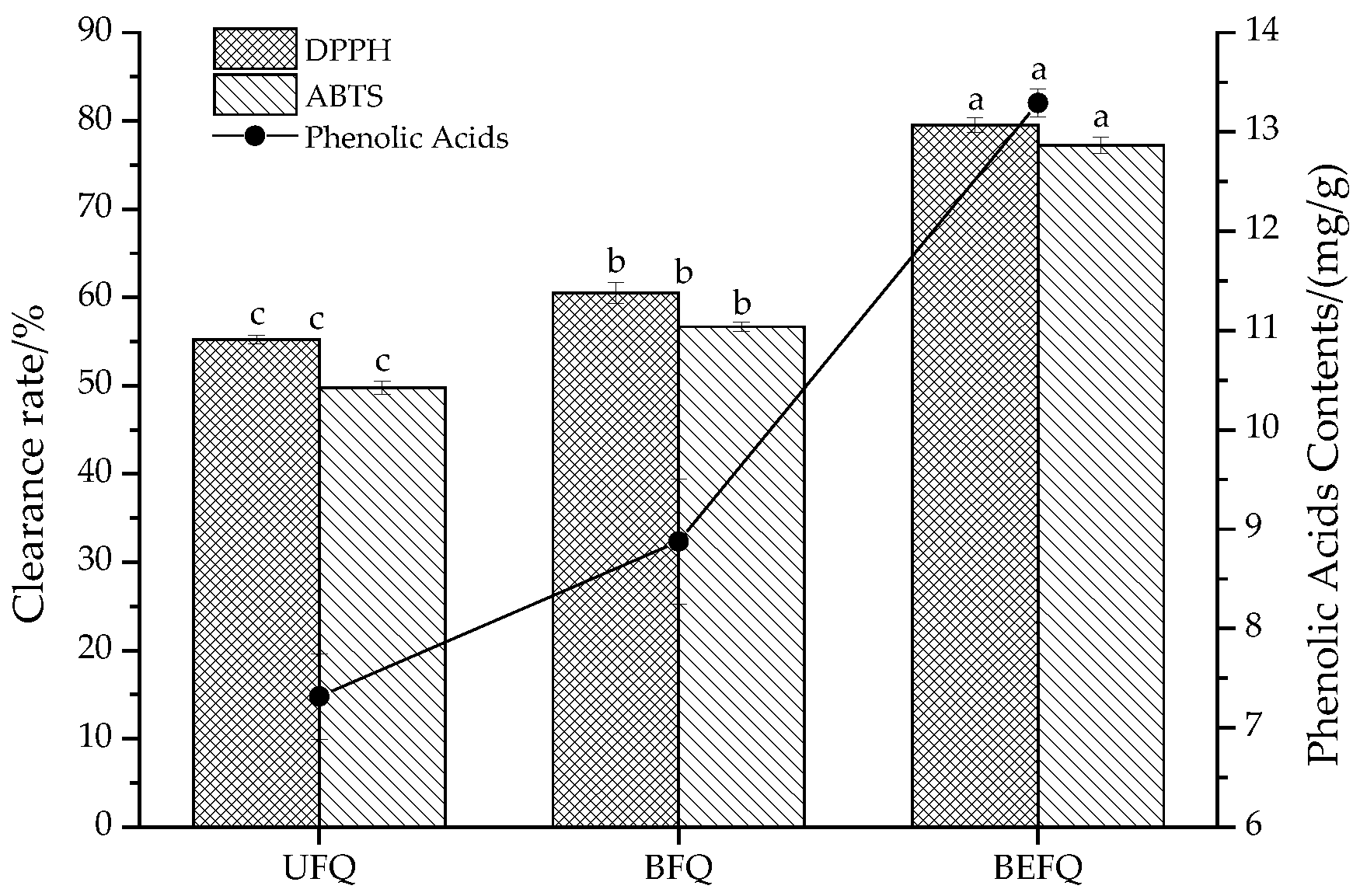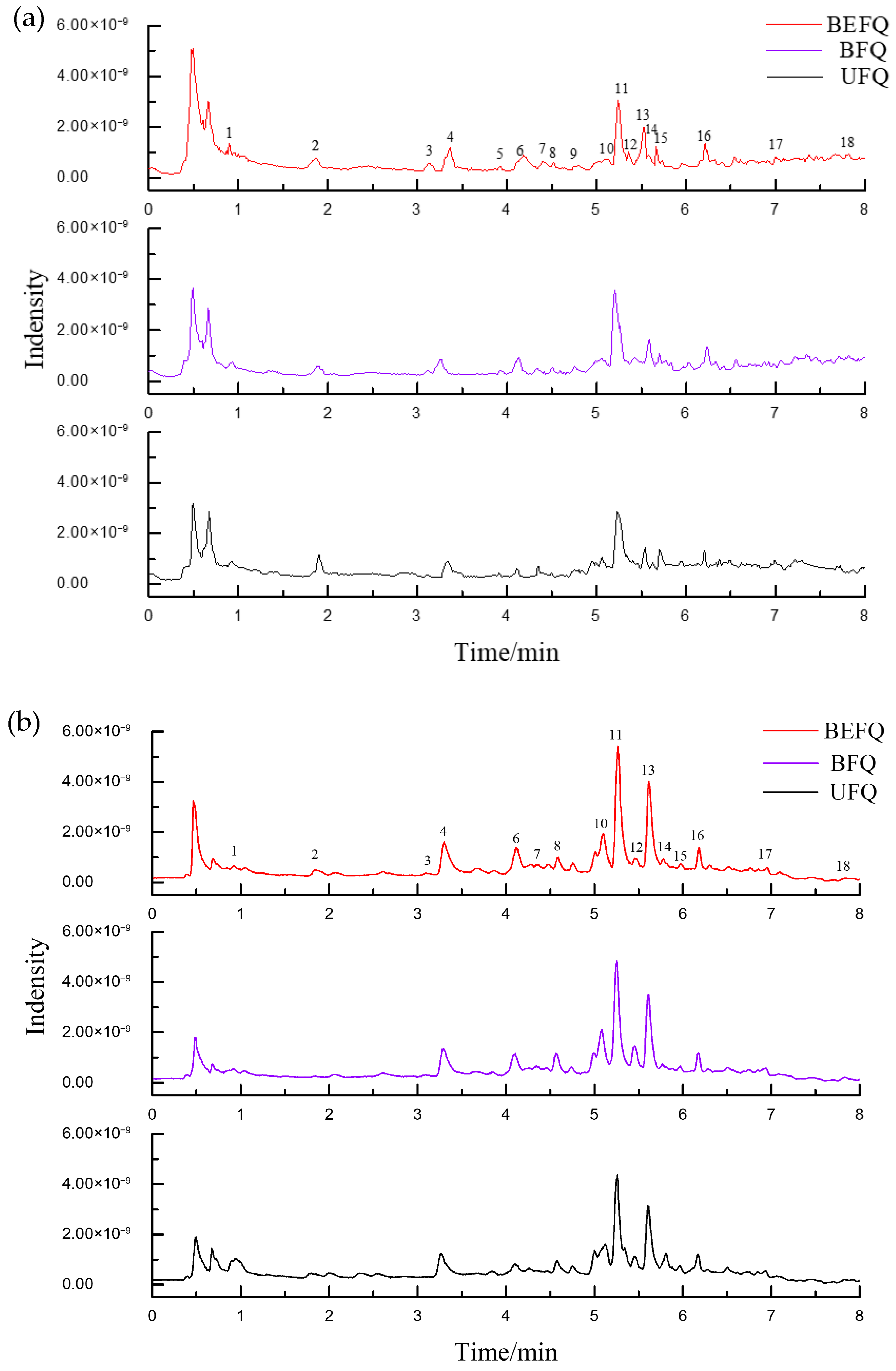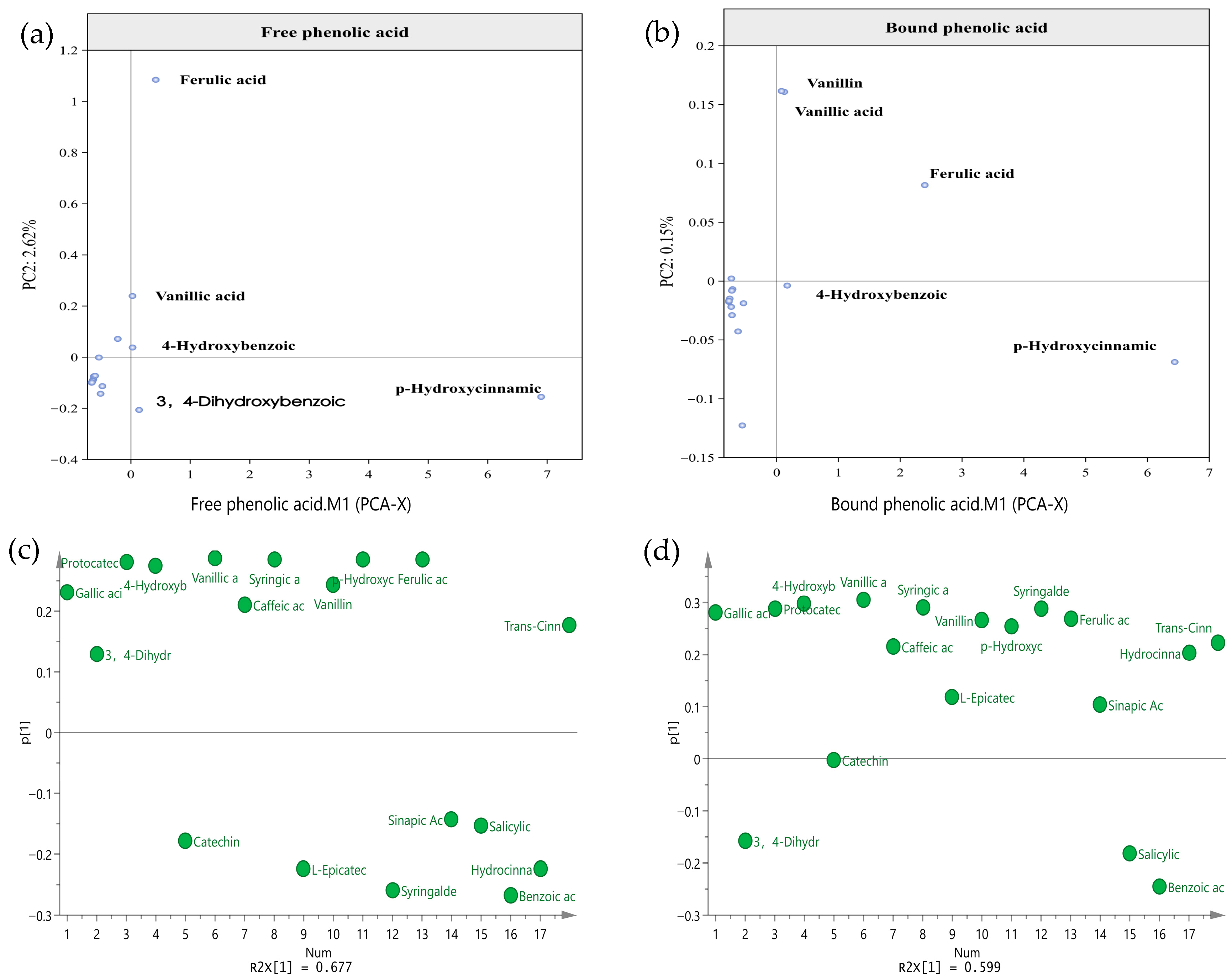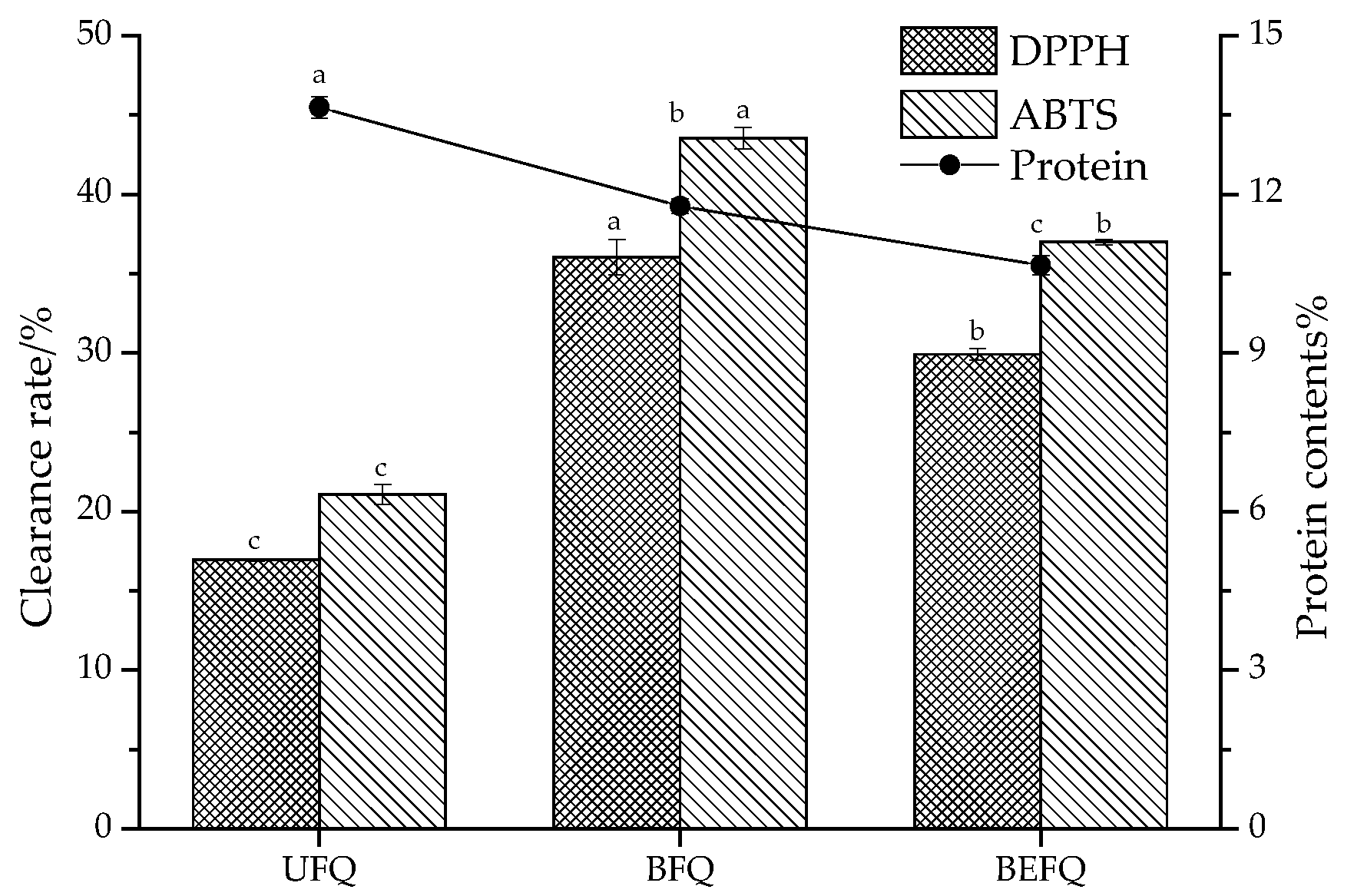Analysis of Functional Component Alterations and Antioxidant Response Mechanisms in Microbial-Enzymatic Co-Fermentation-Induced Quinoa Bran
Abstract
1. Introduction
2. Materials and Methods
2.1. Materials and Reagents
2.2. Methods
2.2.1. Sample Preparation
2.2.2. Antioxidant Activity
2.2.3. Determination of Phenolic Acid Content in Quinoa Bran
2.2.4. Analysis of Phenolic Acid Components Using LC-MS
2.2.5. Extraction and Purification of Major Phenolic Acid Components
2.2.6. Quinoa Bran Polysaccharide Extraction and Content Determination
2.2.7. Molecular Weight Determination of Polysaccharides
2.2.8. Determination of Monosaccharide Composition
2.2.9. Protein Extraction and Quantification
2.2.10. Free Amino Acid Composition Analysis
2.2.11. Data Processing and Analysis
3. Results
3.1. Phenolic Acid Content and Antioxidant Capacity of Quinoa Bran
3.2. Characterization of Phenolic Acid Composition
3.3. Principal Component Analysis (PCA) of Phenolic Acids in Quinoa Bran
3.4. Antioxidant Capacity of Phenolic Acids
3.5. Polysaccharide Content and Antioxidant Capacity of Quinoa Bran
3.6. Molecular Weight of Quinoa Bran Polysaccharides
3.7. Monosaccharide Composition of Quinoa Bran Polysaccharides
3.8. Protein Content and Antioxidant Capacity of Quinoa Bran
3.9. Amino Acid Composition of Quinoa Bran
4. Conclusions
Author Contributions
Funding
Institutional Review Board Statement
Informed Consent Statement
Data Availability Statement
Conflicts of Interest
References
- Zhou, X.; Yue, T.; Wei, Z.; Yang, L.; Zhang, L.; Wu, B. Evaluation of nutritional value, bioactivity and mineral content of quinoa bran in China and its potential use in the food industry. Curr. Res. Food Sci. 2023, 7, 100562. [Google Scholar] [CrossRef]
- Yang, F.; Guo, T.; Zhou, Y.; Han, S.; Sun, S.; Luo, F. Biological functions of active ingredients in quinoa bran: Advance and prospective. Crit. Rev. Food Sci. Nutr. 2024, 64, 4101–4115. [Google Scholar] [CrossRef]
- Akbari, M.; Gómez-Urios, C.; Razavi, S.H.; Khodaiyan, F.; Blesa, J.; Esteve, J.M. Optimization of solid-state fermentation conditions to improve phenolic content in corn bran, followed by extraction of bioactive compounds using natural deep eutectic solvents. Innov. Food Sci. Emerg. Technol. 2024, 93, 103621. [Google Scholar] [CrossRef]
- Niu, X.; Tao, Y.; Wang, Q.; Xu, M.; Zhang, F.; Xie, Y.; Xiao, H. Postharvest ripening-induced modification of cell wall polysaccharide affects plum phenolic bioavailability. Food Biosci. 2025, 479, 143780. [Google Scholar] [CrossRef] [PubMed]
- Chen, D.; Shi, J.; Hu, X. Enhancement of polyphenol content and antioxidant capacity of oat (Avena nuda L.) bran by cellulase treatment. Appl. Biol. Chem. 2016, 59, 397–403. [Google Scholar] [CrossRef]
- Huang, X.; Wang, N.; Ma, Y.; Liu, X.; Guo, H.; Song, L.; Zhao, Q.; Hai, D.; Cheng, Y.; Bai, G.; et al. Flaxseed polyphenols: Effects of varieties on its composition and antioxidant capacity. Food Chem. X 2024, 23, 101597. [Google Scholar] [CrossRef]
- Chao, E.; Fan, L. Changes in polyphenolic compounds and antioxidant activities of seed-used pumpkin during hydrothermal treatment. Food Chem. 2023, 414, 135646. [Google Scholar] [CrossRef]
- Srinivasu, S.R.; Eligar, S.M. Physico-chemical and techno-functional characterization of quinoa bran protein concentrate. J. Cereal Sci. 2024, 116, 103835. [Google Scholar] [CrossRef]
- Ge, Y.; Wei, C.; Arumugam, U.R.; Wu, Y.; Cao, L. Quinoa bran insoluble dietary fiber-zinc chelate mediates intestinal flora structure to regulate glucose and lipid metabolism in obese rats. J. Funct. Foods 2023, 108, 105765. [Google Scholar] [CrossRef]
- Liu, J.; Wang, Z.; Mai, P.; Hao, Y.; Wang, Z.; Wang, J. Quinoa bran soluble dietary fiber ameliorates dextran sodium sulfate induced ulcerative colitis in BALB/c mice by maintaining intestinal barrier function and modulating gut microbiota. Int. J. Biol. Macromol. 2022, 216, 75–85. [Google Scholar] [CrossRef]
- Ding, M.; Zhang, X.; Shi, J.; Cui, K.; Yang, R.; Liu, F.; Shan, S.; Israr, G.; Li, Z. Terpenoids of quinoa bran suppresses colorectal cancer by inducing cell apoptosis. Food Biosci. 2023, 53, 102615. [Google Scholar] [CrossRef]
- Squeo, G.; Latrofa, V.; Vurro, F.; De Angelis, D.; Caponio, F.; Summo, C.; Pasqualone, A. Developing a Clean Labelled Snack Bar Rich in Protein and Fibre with Dry-Fractionated Defatted Durum Wheat Cake. Foods 2023, 12, 2547. [Google Scholar] [CrossRef]
- Christ-Ribeiro, A.; Chiattoni, L.M.; Mafaldo, C.R.F.; Badiale-Furlong, E.; de Souza-Soares, L.A. Fermented rice-bran by Saccharomyces cerevisiae: Nutritious ingredient in the formulation of gluten-free cookies. Food Biosci. 2021, 40, 100859. [Google Scholar] [CrossRef]
- Zhang, Q.; Li, M.; Cheng, Z.; Meng, J.; Li, Y. Optimization of Polyphenols Release from Highland Barley Bran by Solid-State Fermentation and Antioxidant Activity Characterization. Fermentation 2024, 10, 438. [Google Scholar] [CrossRef]
- Kaced, A.; Belkacemi, L.; Chemat, S.; Taibi, N.; Bensouici, C.; Boussebaa, W.; Menaa, S.; Mustapha, M.A. Assessment of L-DOPA, bioactive molecules and antioxidant activities of the local Algerian legume Tadelaght (Vigna mungo L. Hepper) extract. Food Biosci. 2024, 61, 104902. [Google Scholar] [CrossRef]
- Wu, J.; He, T.; Wang, Z.; Mao, J.; Sha, R. The dynamic analysis of non-targeted metabolomics and antioxidant activity of Dendrobium officinale Kimura et Migo by the synergistic fermentation of bacteria and enzymes. LWT 2024, 203, 116354. [Google Scholar] [CrossRef]
- Guo, Y.; Nan, S.; Qiu, C.; Song, C.; Wu, B.; Tang, Y.; Cheng, L.; Ma, H. Ultrasound-assisted enzymatic extraction of jujube (Ziziphus jujuba Mill.) polysaccharides: Extraction efficiency, antioxidant activity, and structure features. Ultrason. Sonochem. 2024, 111, 107088. [Google Scholar] [CrossRef]
- Zhao, Y.; Sun, J.; Liu, Y.; Zhang, X.; Cao, Y.; Zheng, B.; Zhang, R.; Zhao, C.; Ai, X.; He, H.; et al. Metabolic basis for superior antioxidant capacity of red-fleshed peaches. Food Chem. X 2024, 23, 101698. [Google Scholar] [CrossRef]
- Tepsongkroh, B.; Thaihuttakij, C.; Supawong, S.; Jangchud, K. Impact of high pressure pre-treatment and hot water extraction on chemical properties of crude polysaccharide extract obtained from mushroom (Volvariella volvacea). Food Chem. X 2023, 19, 100864. [Google Scholar] [CrossRef]
- Mir, N.A.; Riar, C.S.; Singh, S. Effect of film forming solution pH on antibacterial, antioxidant and structural characteristics of edible films from modified quinoa protein. Food Hydrocoll. 2023, 135, 108190. [Google Scholar] [CrossRef]
- Wang, Y.; Wang, Y.; Zhou, X.; Du, B.; Che, Y. Release of bound phenol from Rosa roxburghii pomace via solid-state fermentation with Trichoderma viride: Mechanisms of change. Food Biosci. 2024, 61, 105011. [Google Scholar] [CrossRef]
- Adebo, O.A.; Medina-Meza, I.G. Impact of Fermentation on the Phenolic Compounds and Antioxidant Activity of Whole Cereal Grains: A Mini Review. Molecules 2020, 25, 927. [Google Scholar] [CrossRef]
- Truong, V.L.; Jeong, W.S. Cellular Defensive Mechanisms of Tea Polyphenols: Structure-Activity Relationship. Int. J. Mol. Sci. 2021, 22, 9109. [Google Scholar] [CrossRef]
- Abduh, M.Y.; Alyssa, S.; Butar, R.A.; Pane, I.S.S.; Melani, L.; Mohamad Puad, N.I. Effects of solid-state fermentation using Aspergillus niger on yield, total phenolic content, and antioxidant activity of defatted rice bran extract. Food Chem. Adv. 2025, 7, 100957. [Google Scholar] [CrossRef]
- Byanju, B.; Lamsal, B.P. Effects of Lactiplantibacillus plantarum and Bacillus subtilis fermentation on the constituents of ground or extruded corn bran. Food Res. Int. 2025, 203, 115812. [Google Scholar] [CrossRef] [PubMed]
- Ma, Y.; Shi, Q.; He, Q.; Chen, G. Metabolomic insights into the inhibition mechanism of methyl N-methylanthranilate: A novel quorum sensing inhibitor and antibiofilm agent against Pseudomonas aeruginosa. Int. J. Food Microbiol. 2021, 358, 109402. [Google Scholar] [CrossRef]
- Adebo, O.A.; Oyedeji, A.B.; Adebiyi, J.A.; Chinma, C.E.; Oyeyinka, S.A.; Olatunde, O.O.; Green, E.; Njobeh, P.B.; Kondiah, K. Kinetics of Phenolic Compounds Modification during Maize Flour Fermentation. Molecules 2021, 26, 6702. [Google Scholar] [CrossRef]
- Skrajda-Brdak, M.; Konopka, I.; Tańska, M.; Czaplicki, S. Changes in the content of free phenolic acids and antioxidative capacity of wholemeal bread in relation to cereal species and fermentation type. Eur. Food Res. Technol. 2019, 245, 2247–2256. [Google Scholar] [CrossRef]
- Lei, Q.; Wang, J.; Li, Q.; Li, J.; Wang, X.; Mao, N.; Sun, P.; Ding, T.; Deng, Y. Effects of Latilactobacillus delbrueckii fermentation on the bioconversion and antioxidant capacity of phenolic compounds in quinoa sprouts. Food Biosci. 2024, 59, 104190. [Google Scholar] [CrossRef]
- Altıkardeş, E.; Güzel, N. Impact of germination pre-treatments on buckwheat and Quinoa: Mitigation of anti-nutrient content and enhancement of antioxidant properties. Food Chem. X 2024, 21, 101182. [Google Scholar] [CrossRef]
- Călinoiu, L.F.; Cătoi, A.F.; Vodnar, D.C. Solid-State Yeast Fermented Wheat and Oat Bran as A Route for Delivery of Antioxidants. Antioxidants 2019, 8, 372. [Google Scholar] [CrossRef] [PubMed]
- Ma, Y.; Chen, R.; Chen, Z.; Zhang, S. Insight into structure-activity relationships of hydroxycinnamic acids modified porous starch: The effect of phenolic hydroxy groups. Food Chem. 2023, 426, 136683. [Google Scholar] [CrossRef] [PubMed]
- Mura, F.; Silva, T.; Castro, C.; Borges, F.; Zuñiga, M.C.; Morales, J.; Olea-Azar, C. New insights into the antioxidant activity of hydroxycinnamic and hydroxybenzoic systems: Spectroscopic, electrochemistry, and cellular studies. Free Radic. Res. 2014, 48, 1473–1484. [Google Scholar] [CrossRef]
- Granato, D.; Grevink, R.; Zielinski, A.A.F.; Nunes, D.S.; van Ruth, S.M. Analytical Strategy Coupled with Response Surface Methodology To Maximize the Extraction of Antioxidants from Ternary Mixtures of Green, Yellow, and Red Teas (Camellia sinensis var. sinensis). J. Agric. Food Chem. 2014, 62, 10283–10296. [Google Scholar] [CrossRef] [PubMed]
- Wu, F.; Lin, B.; Chen, J.; Zheng, F.; Yang, Y.; Rasheed, U.; Chen, G. Mechanistic Insights into the Antioxidant Potential of Sugarcane Vinegar Polyphenols: A Combined Approach of DPPH-UPLC-MS, Network Pharmacology and Molecular Docking. Foods 2024, 13, 3379. [Google Scholar] [CrossRef]
- Chen, L.; Wang, Z.; Mao, Y.; Chen, Y.; Li, J. Effect of solid-state co-fermentation on the structural characteristics and bioactivities of polysaccharides in the medicinal residues of Gastrodia Ganoderma. Food Biosci. 2024, 61, 104945. [Google Scholar] [CrossRef]
- Agoda-Tandjawa, G.; Durand, S.; Gaillard, C.; Garnier, C.; Doublier, J.L. Properties of cellulose/pectins composites: Implication for structural and mechanical properties of cell wall. Carbohydr. Polym. 2012, 90, 1081–1091. [Google Scholar] [CrossRef]
- Wang, X.; Su, Y.; Su, J.; Xue, J.; Zhang, R.; Li, X.; Li, Y.; Ding, Y.; Chu, X. Optimization of Enzyme − Assisted Aqueous Extraction of Polysaccharide from Acanthopanax senticosus and Comparison of Physicochemical Properties and Bioactivities of Polysaccharides with Different Molecular Weights. Molecules 2023, 28, 6585. [Google Scholar] [CrossRef]
- Fu, Z.; Sun, X.; Zhu, K.; Guo, X. Improving the quality of frozen steamed stuffed buns after freeze-thaw cycles: Synergistic effects of cellulase, xylanase and sourdough. Food Biosci. 2025, 68, 106524. [Google Scholar] [CrossRef]
- Perović, M.N.; Pajin, B.S.; Antov, M.G. The effect of enzymatic pretreatment of chickpea on functional properties and antioxidant activity of alkaline protein isolate. Food Chem. 2022, 374, 131809. [Google Scholar] [CrossRef]
- Wen, C.; Zhang, J.; Feng, Y.; Duan, Y.; Ma, H.; Zhang, H. Purification and identification of novel antioxidant peptides from watermelon seed protein hydrolysates and their cytoprotective effects on H2O2-induced oxidative stress. Food Chem. 2020, 327, 127059. [Google Scholar] [CrossRef] [PubMed]
- Aboobacker, S.; Kitrytė-Syrpa, V.; Šipailienė, A.; Rutkaitė, R.; Syrpas, M. Fermentation-induced nutritional and in vitro antioxidant capacity changes in Arthrospira platensis (spirulina). Food Biosci. 2025, 68, 106747. [Google Scholar] [CrossRef]
- Shi, C.; Liu, M.; Zhao, H.; Lv, Z.; Liang, L.; Zhang, B. A Novel Insight into Screening for Antioxidant Peptides from Hazelnut Protein: Based on the Properties of Amino Acid Residues. Antioxidants 2022, 11, 127. [Google Scholar] [CrossRef] [PubMed]
- Cui, X.; Xie, Y.; Xu, M.; Gao, Y. Sulfur-containing amino acids enhanced antioxidant of yellow mealworm proteins: GPx4 activation through structural modulation evidenced by spectroscopy method. Food Chem. X 2025, 28, 102562. [Google Scholar] [CrossRef] [PubMed]






| Name | Fermentation Time (h) | Liquid to Solid Ratio (mL/g) | Bacillus subtilis (OD600 = 0.8–0.9) Inoculation Amount (%) | Cellulase Dosage (u/g) |
|---|---|---|---|---|
| UFQ | - | - | - | - |
| BFQ | 121 | 1.9 | 8 | - |
| BEFQ | 121 | 1.9 | 8 | 85 |
| Free Phenolic Acid | Bound Phenolic Acid | |||||
|---|---|---|---|---|---|---|
| Sample (ng/mg) | UFQ | BFQ | BEFQ | UFQ | BFQ | BEFQ |
| Gallic acid | 0.40 ± 0.02 c | 0.68 ± 0.06 b | 1.87 ± 0.02 a | 0.26 ± 0.05 b | 0.29 ± 0.08 b | 0.59 ± 0.01 a |
| 3,4-Dihydroxybenzoic acid | 30.22 ± 0.25 a | 6.57 ± 0.44 c | 19.00 ± 0.87 b | 4.87 ± 0.12 b | 1.84 ± 0.51 c | 9.82 ± 0.51 a |
| Protocatechualdehyde | 0.24 ± 0.03 b | 1.96 ± 0.18 a | 2.29 ± 0.35 a | 0.31 ± 0.02 a | 1.29 ± 0.62 a | 1.46 ± 0.17 a |
| 4-Hydroxybenzoic acid | 12.21 ± 0.14 b | 15.82 ± 1.34 b | 21.97 ± 1.26 a | 18.52 ± 0.21 b | 21.18 ± 1.23 ab | 24.96 ± 1.43 a |
| Catechin | 0.02 ± 0.00 a | 0.06 ± 0.00 a | 0.02 ± 0.00 a | NF | NF | NF |
| Vanillic acid | 2.38 ± 0.18 c | 16.08 ± 1.02 b | 28.50 ± 1.69 a | 12.91 ± 0.13 b | 22.51 ± 1.06 a | 26.91 ± 2.57 a |
| Caffeic acid | 0.48 ± 0.04 b | 1.90 ± 0.10 b | 6.87 ± 0.87 a | 0.94 ± 0.04 b | 0.88 ± 0.06 b | 2.47 ± 0.35 a |
| Syringic acid | 0.16 ± 0.03 b | 0.92 ± 0.05 ab | 1.10 ± 0.32 a | 0.73 ± 0.08 b | 1.27 ± 0.17 ab | 1.44 ± 0.11 a |
| L-Epicatechin | 0.02 ± 0.00 a | 0.01 ± 0.00 a | 0.03 ± 0.00 a | NF | NF | NF |
| Vanillin | 1.17 ± 0.02 b | 15.99 ± 1.78 a | 15.63 ± 1.64 a | 11.97 ± 0.09 b | 25.14 ± 2.05 a | 22.04 ± 0.19 a |
| p-Hydroxycinnamic Acid | 166.05 ± 4.19 b | 188.45 ± 3.12 a | 185.97 ± 2.98 a | 145.40 ± 1.31 b | 168.52 ± 3.77 a | 177.46 ± 3.16 a |
| Syringaldehyde | 0.12 ± 0.01 a | 0.65 ± 0.02 a | 0.75 ± 0.00 a | 1.38 ± 0.05 a | 1.24 ± 0.13 ab | 0.90 ± 0.00 b |
| Ferulic acid | 3.30 ± 0.08 b | 8.85 ± 1.63 b | 69.33 ± 2.33 a | 60.54 ± 2.11 b | 73.56 ± 2.16 a | 82.83 ± 3.18 a |
| Sinapic Acid | 0.50 ± 0.03 b | 0.08 ± 0.00 c | 0.76 ± 0.01 a | 0.93 ± 0.04 a | 1.02 ± 0.09 a | 0.76 ± 0.02 a |
| Salicylic acid | 5.05 ± 0.16 a | 3.61 ± 0.22 a | 4.25 ± 0.52 a | 3.73 ± 0.07 a | 2.94 ± 0.23 a | 3.45 ± 0.27 a |
| Benzoic acid | 5.82 ± 0.35 a | 2.05 ± 0.11 b | 2.71 ± 0.17 b | 7.34 ± 0.21 a | 3.42 ± 0.12 b | 3.56 ± 0.13 b |
| Hydrocinnamic acid | 0.04 ± 0.00 b | 0.03 ± 0.00 b | 0.08 ± 0.01 a | 0.03 ± 0.00 a | 0.02 ± 0.00 a | 0.03 ± 0.00 a |
| Trans-Cinnamic acid | 0.18 ± 0.01 a | 0.17 ± 0.03 a | 0.22 ± 0.02 a | 0.08 ± 0.02 b | 0.14 ± 0.00 a | 0.11 ± 0.00 ab |
| Name | Category | Structural Formula | Molecular Formula | Molecular Weight | DPPH (IC50 µg/mL) | ABTS (IC50 µg/mL) |
|---|---|---|---|---|---|---|
| Ferulic acid | Hydroxycinnamic acid |  | C10H10O4 | 194.18 | 15.19 ± 0.62 c | 5.19 ± 0.56 b |
| p-Hydroxycinnamic Acid |  | C9H8O3 | 164.16 | 15.86 ± 0.38 c | 4.84 ± 0.31 b | |
| 4-Hydroxybenzoic acid | Hydroxybenzoic acid |  | C7H6O3 | 138.12 | 25.86 ± 0.18 a | 7.27 ± 0.29 a |
| Vanillic acid |  | C8H8O4 | 168.14 | 20.82 ± 0.67 b | 6.32 ± 0.21 a | |
| Ascorbic acid | Polyhydroxyl compound |  | C6H8O6 | 176.12 | 5.19 ± 0.08 d | 2.92 ± 0.06 c |
| Name | Mn (×10 5Da) | Mw (×10 5Da) | Mw/Mn |
|---|---|---|---|
| UFQ | 4.124 ± 0.396 a | 4.700 ± 0.325 a | 1.140 ± 0.31 a |
| BFQ | 2.821 ± 0.297 ab | 2.863 ± 0.240 b | 1.015 ± 0.021 a |
| BEFQ | 1.844 ± 0.185 b | 2.243 ± 0.156 b | 1.216 ± 0.037 a |
| Ara (mg/g) | Rha (mg/g) | Gal (mg/g) | Glc (mg/g) | Gal-UA (mg/g) | Glc-UA (mg/g) | |
|---|---|---|---|---|---|---|
| UFQ | 16.17 ± 0.36 c | 3.72 ± 0.16 a | 13.05 ± 0.73 a | 163.25 ± 1.01 c | 13.20 ± 1.06 a | 16.24 ± 1.13 a |
| BFQ | 19.46 ± 1.02 b | 3.90 ± 0.21 a | 12.75 ± 0.88 a | 209.93 ± 1.23 b | 15.70 ± 0.97 a | 13.88 ± 0.61 a |
| BEFQ | 22.46 ± 0.64 a | 3.64 ± 0.33 a | 12.14 ± 0.69 a | 243.97 ± 1.14 a | 11.82 ± 0.65 a | 13.24 ± 0.99 a |
| Name | UFQ | BFQ | BEFQ |
|---|---|---|---|
| EAA/(ug/g) | |||
| Phenylalanine (Phe) h | 22.02 ± 1.03 c | 854.87 ± 6.31 a | 231.80 ± 5.22 b |
| Methionine (Met) h | 1.59 ± 0.05 c | 244.86 ± 10.13 a | 49.87 ± 2.15 b |
| Lysine (Lys) | 34.55 ± 2.35 c | 463.62 ± 16.77 a | 171.11 ± 8.23 b |
| Leucine (Leu) h | 25.53 ± 0.13 c | 153.83 ± 6.44 b | 315.56 ± 10.19 a |
| Tryptophan (Trp) | 12.86 ± 0.83 c | 178.50 ± 8.04 a | 71.29 ± 6.33 b |
| Threonine (Thr) | 33.02 ± 0.97 c | 69.78 ± 1.05 b | 88.57 ± 1.85 a |
| Valine (Val) h | 40.31 ± 0.55 c | 126.28 ± 1.52 b | 136.83 ± 1.37 a |
| Isoleucine (Ile) h | 20.83 ± 0.05 b | 88.30 ± 2.33 a | 86.53 ± 2.39 a |
| Histidine (His) | 9.09 ± 0.09 b | 8.73 ± 0.12 b | 208.48 ± 4.37 a |
| NEAA/(ug/g) | |||
| Alanine (Ala) h | 90.54 ± 2.13 c | 201.28 ± 3.10 b | 268.48 ± 3.64 a |
| Glycine (Gly) | 50.73 ± 1.59 b | 96.53 ± 2.13 a | 102.73 ± 4.16 a |
| Glutamic acid (Glu) | 319.35 ± 5.78 b | 345.42 ± 6.11 b | 455.95 ± 5.69 a |
| Arginine (Arg) | 251.50 ± 8.83 b | 102.65 ± 6.12 c | 999.70 ± 12.14 a |
| Tyrosine (Tyr) | 35.08 ± 0.12 c | 917.16 ± 14.16 a | 216.62 ± 7.21 b |
| Proline (Pro) h | 115.54 ± 4.67 b | 69.14 ± 5.26 c | 351.70 ± 7.34 a |
| Serine (Ser) | 50.55 ± 0.56 b | 49.13 ± 0.69 b | 137.06 ± 3.44 a |
| Aspartic acid (Asp) | 108.35 ± 3.99 b | 67.55 ± 1.14 c | 216.31 ± 4.09 a |
| Ornithine (Orn) | 5.70 ± 0.05 b | 34.82 ± 0.34 a | 1.32 ± 0.00 c |
| Citrulline (Cit) | 2.45 ± 0.01 b | 16.98 ± 0.58 a | 3.61 ± 0.10 b |
| Total EAA/(ug/g) | 199.80 ± 2.59 c | 2188.77 ± 20.17 a | 1360.04 ± 10.21 b |
| HAA/(ug/g) | 329.22 ± 6.12 c | 1917.06 ± 13.33 a | 1512.06 ± 12.35 b |
| Total AA/(ug/g) | 1229.59 ± 10.79 b | 4089.43 ± 15.32 a | 4113.52 ± 22.28 a |
| EAA/AA | 0.16 | 0.54 | 0.33 |
| HAA/AA | 0.27 | 0.47 | 0.37 |
Disclaimer/Publisher’s Note: The statements, opinions and data contained in all publications are solely those of the individual author(s) and contributor(s) and not of MDPI and/or the editor(s). MDPI and/or the editor(s) disclaim responsibility for any injury to people or property resulting from any ideas, methods, instructions or products referred to in the content. |
© 2025 by the authors. Licensee MDPI, Basel, Switzerland. This article is an open access article distributed under the terms and conditions of the Creative Commons Attribution (CC BY) license (https://creativecommons.org/licenses/by/4.0/).
Share and Cite
Li, M.; Zhang, Q.; Meng, J. Analysis of Functional Component Alterations and Antioxidant Response Mechanisms in Microbial-Enzymatic Co-Fermentation-Induced Quinoa Bran. Fermentation 2025, 11, 546. https://doi.org/10.3390/fermentation11090546
Li M, Zhang Q, Meng J. Analysis of Functional Component Alterations and Antioxidant Response Mechanisms in Microbial-Enzymatic Co-Fermentation-Induced Quinoa Bran. Fermentation. 2025; 11(9):546. https://doi.org/10.3390/fermentation11090546
Chicago/Turabian StyleLi, Min, Qianfang Zhang, and Jingyan Meng. 2025. "Analysis of Functional Component Alterations and Antioxidant Response Mechanisms in Microbial-Enzymatic Co-Fermentation-Induced Quinoa Bran" Fermentation 11, no. 9: 546. https://doi.org/10.3390/fermentation11090546
APA StyleLi, M., Zhang, Q., & Meng, J. (2025). Analysis of Functional Component Alterations and Antioxidant Response Mechanisms in Microbial-Enzymatic Co-Fermentation-Induced Quinoa Bran. Fermentation, 11(9), 546. https://doi.org/10.3390/fermentation11090546






